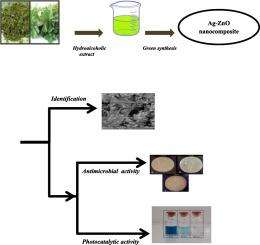Spectrochimica Acta Part A: Molecular and Biomolecular Spectroscopy ( IF 4.4 ) Pub Date : 2020-06-11 , DOI: 10.1016/j.saa.2020.118595 Zahra Noohpisheh 1 , Hamzeh Amiri 1 , Saeed Farhadi 2 , Abdolnaser Mohammadi-Gholami 1

|
In the present study, biological synthesis of Ag-ZnO nanocomposites was performed using hydroalcoholic extract of fenugreek leaves. Metal/semiconductor oxide nanocomposites are excellent owing to their optical, electrical, magnetic, and chemical properties that are not detected in single individual constituents. The synthesized Ag-ZnO nanocomposites were investigated through the use of methods such as FTIR, UV vis DRS, SEM-EDX, TEM, XRD, zeta potential analysis, and DLS. The synthesized Ag-ZnO nanocomposites had an average particle size of about 75 nm and a zeta potential of −37.5 mV. The XRD results confirmed that Ag was successfully introduced into the Ag-ZnO nanocomposites via a hydrothermal method. The antimicrobial and antifungal activities of Ag-ZnO nanocomposites were evaluated by agar well diffusion method against three microbial and fungal strains; it was found that the Ag-ZnO nanocomposites were toxic against all the tested microbial and fungal strains. Ag-ZnO nanocomposites was observed to have significant antioxidant activity against DPPH (2,2-diphenyl-1-picrylhydrazyl) free radicals. The Ag-ZnO nanocomposites exhibited excellent photocatalytic activity and stability against the degradation of malachite green under visible light irradiation. The study successfully applied a simple and eco-friendly method for synthesizing efficient multifunctional Ag-ZnO nanocomposites using green synthetic approach.
中文翻译:

木瓜叶提取物绿色合成Ag-ZnO纳米复合材料及其抗菌,抗真菌,抗氧化和光催化性能。
在本研究中,使用胡芦巴叶的水醇提取物进行了Ag-ZnO纳米复合材料的生物合成。金属/半导体氧化物纳米复合材料具有出色的光学,电,磁和化学特性,因此无法在单个单独成分中检测到。通过诸如FTIR,UV vis DRS,SEM-EDX,TEM,XRD,ζ电势分析和DLS等方法研究了合成的Ag-ZnO纳米复合材料。合成的Ag-ZnO纳米复合材料具有约75nm的平均粒径和-37.5mV的ζ电位。XRD结果证实,通过水热法将Ag成功地引入到Ag-ZnO纳米复合材料中。用琼脂微孔扩散法评价了Ag-ZnO纳米复合材料对三种微生物和真菌的抗菌活性。发现Ag-ZnO纳米复合材料对所有测试的微生物和真菌菌株均具有毒性。观察到Ag-ZnO纳米复合材料对DPPH(2,2-二苯基-1-picylhydrazyl)自由基具有显着的抗氧化活性。Ag-ZnO纳米复合材料在可见光照射下表现出优异的光催化活性和对孔雀石绿降解的稳定性。该研究成功地应用了一种简单且环保的方法,通过绿色合成方法合成了高效的多功能Ag-ZnO纳米复合材料。观察到Ag-ZnO纳米复合材料对DPPH(2,2-二苯基-1-picylhydrazyl)自由基具有显着的抗氧化活性。Ag-ZnO纳米复合材料在可见光照射下表现出优异的光催化活性和对孔雀石绿降解的稳定性。该研究成功地应用了一种简单且环保的方法,通过绿色合成方法合成了高效的多功能Ag-ZnO纳米复合材料。观察到Ag-ZnO纳米复合材料对DPPH(2,2-二苯基-1-picylhydrazyl)自由基具有显着的抗氧化活性。Ag-ZnO纳米复合材料在可见光照射下表现出优异的光催化活性和对孔雀石绿降解的稳定性。该研究成功地应用了一种简单而环保的方法,即通过绿色合成方法合成高效的多功能Ag-ZnO纳米复合材料。

























 京公网安备 11010802027423号
京公网安备 11010802027423号